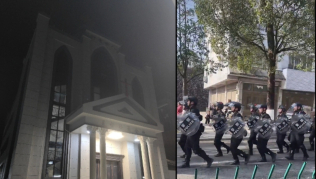
Because "The Ten Commandments" movie set within California's Guadalupe-Nipomo Dunes wasn't restored to its natural state, as originally planned when the movie was created in the 1920s, unanticipated relics have begun surfacing. Archeologists recently flew over the movie's former area in central California to spot the gems from beneath shifting sand. They specifically are searching for the camp that anchored the team who developed the silent film.
M. Colleen Hamilton, an archeologist with Applied Earthworks, the company assisting with the search, said Ten Commandments' director Cecil B. DeMille's studio had a contract to return the area to its original state once the filming was complete. But "evidence shows that didn't happen," Hamilton told KCBX-FM Central Coast Radio.
The Guadalupe-Nipomo Dunes are a National Natural Landmark.
A giant sphinx was found in the dunes earlier this year, and it's currently on display at the nonprofit Dunes Center in Guadalupe. More remains are expected to be found from a "lost city" that boasted a huge temple, four more sphinxes, massive statues, a 750-foot-long wall, and amenities.
Hamilton said roughly 2,500 people lived in the camp for several months during the film's production.
"We have one historical photograph of the camp itself and we're trying to align that with features that are currently on the ground to relocate the location," said Hamilton during the KCBX interview.
DeMille reportedly called the spot "perhaps the most unpleasant location in cinema history," according to Outside.
Instead of restoring the film set, Outside reports DeMille supposedly blew it up with dynamite to spite rival directors.
Applied Earthworks staffers soon will resume the search on the ground, Hamilton told KCBX.
Doug Jenzen, executive director of the Dunes Center, told Outside that minerals in the sand, which are "a natural desiccant," have preserved the artifacts remarkably well. However, he said, according to a Nov. 28 Newser article, the sands of the dunes are changing, leaving the old movie props endangered. "It's disappearing so fast," he said.
DeMille's first Commandments' movie was released in 1923; his second version, starring Charlton Heston as Moses and Yul Brynner as Pharaoh Rameses II, opened in 1956. The 308-page script and basic plot of the second one were said to take shape out of the very pages of the Bible; in fact, Biblical verses reportedly were inserted into the margins of the script. It was the 70th film of his career. Unlike the first, it was filmed in Egypt.
In DeMille's autobiography, he was quoted as saying, "The Bible was timeless. It was also timely."
"Man has made 32 million laws since The Commandments were handed down to Moses on Mount Sinai more than 3,000 years ago, but he has never improved on God's law," said DeMille.
"The Ten Commandments are the principles by which man may live with God and man may live with man. They are the expressions of the mind of God for His creatures. They are the charter and guide of human liberty, for there can be no liberty without the law. What I hope for our production of The Ten Commandments is that those who see it shall come from the theater not only entertained and filled with the sight of a big spectacle but filled with the spirit of truth. That it will bring to its audience a better understanding of the real meaning of this pattern of life that God has set down for us to follow."







